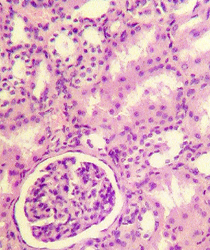The body abounds with tubes of
various diameters.
- The tubes most often seen in
histological sections are blood vessels and their accompanying
lymphatics (the tubes that carry lymph).
- Also, many glands are furnished
with tubular ducts that carry their secretions.
- Tubes are not difficult to
recognize if they are cut transversely.
- But if they are cut
longitudinally or obliquely, or if they are cut at a site where
they curve, it is important to think in three dimensions to
recognize them as tubes.
Examine a specimen such as kidney with many tubes in many different orientations. Identify
tubular structures cut transversely, longitudinally, and
obliquely.
Why is interpretation of a
small structure’s shape particularly difficult when it is cut in an
oblique or tangential plane?
Artifacts can
make interpretation difficult. |